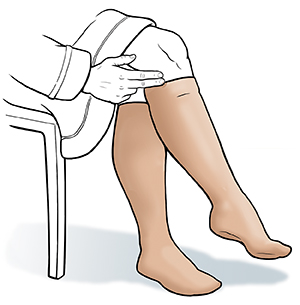Self-Care for Spider and Varicose Veins
Your healthcare provider may suggest that you try self-care. Exercising and maintaining a healthy weight may keep problem veins from getting worse. Wearing elastic stockings and elevating your legs can help improve blood flow. Taking breaks when you sit or stand helps, too.
Exercising
Exercising is good for your veins because it improves blood flow. Walking, cycling, or swimming are great exercises for vein health. But be sure to check with your healthcare provider before starting any exercise program. Also keep these hints in mind:
-
When exercising, start out slowly and try to build up to 30 minutes on most days.
-
Elevate your legs above heart level after exercise to keep blood from pooling in veins.
Staying at a healthy weight
Being overweight puts extra pressure on your veins. To stay at a healthy weight, try these tips:
-
Choose lean meats, fish, and skinless chicken.
-
Use low-fat dairy products.
-
Eat foods high in fiber, such as whole grains, fruits, and vegetables.
-
Cut down on sugar, salt, and saturated and trans fats.
-
Exercise regularly.
Wearing elastic stockings
Elastic stockings gently squeeze veins so blood flows upward. If you need elastic stockings, your healthcare provider can prescribe them for you. Follow your healthcare provider’s advice about how and when to wear them. Elastic stockings come in several different levels of pressure. Ask your healthcare provider which level of pressure would help you the most.
 |
| The top of the elastic stocking should be below the bend in your knee for a proper fit. |
Elevating your legs
Raising your legs above heart level will help relieve swelling and keep blood from pooling in veins. Try to elevate your legs for 15 to 20 minutes at the end of the day, and whenever you’re relaxing. To make sure your legs are raised above heart level, prop them up on cushions or large pillows.
When sitting and standing
To keep blood moving when you have to sit or stand for long periods, try these tips:
-
At work, take walking breaks instead of coffee breaks. Walk during your lunch hour. Or try flexing your feet up and down 10 times each hour.
-
When standing, raise yourself up and down on your toes, or rock back and forth on your heels.
Online Medical Reviewer:
Anne Fetterman RN BSN
Online Medical Reviewer:
Deepak Sudheendra MD
Online Medical Reviewer:
Raymond Kent Turley BSN MSN RN
Date Last Reviewed:
7/1/2022
© 2000-2024 The StayWell Company, LLC. All rights reserved. This information is not intended as a substitute for professional medical care. Always follow your healthcare professional's instructions.